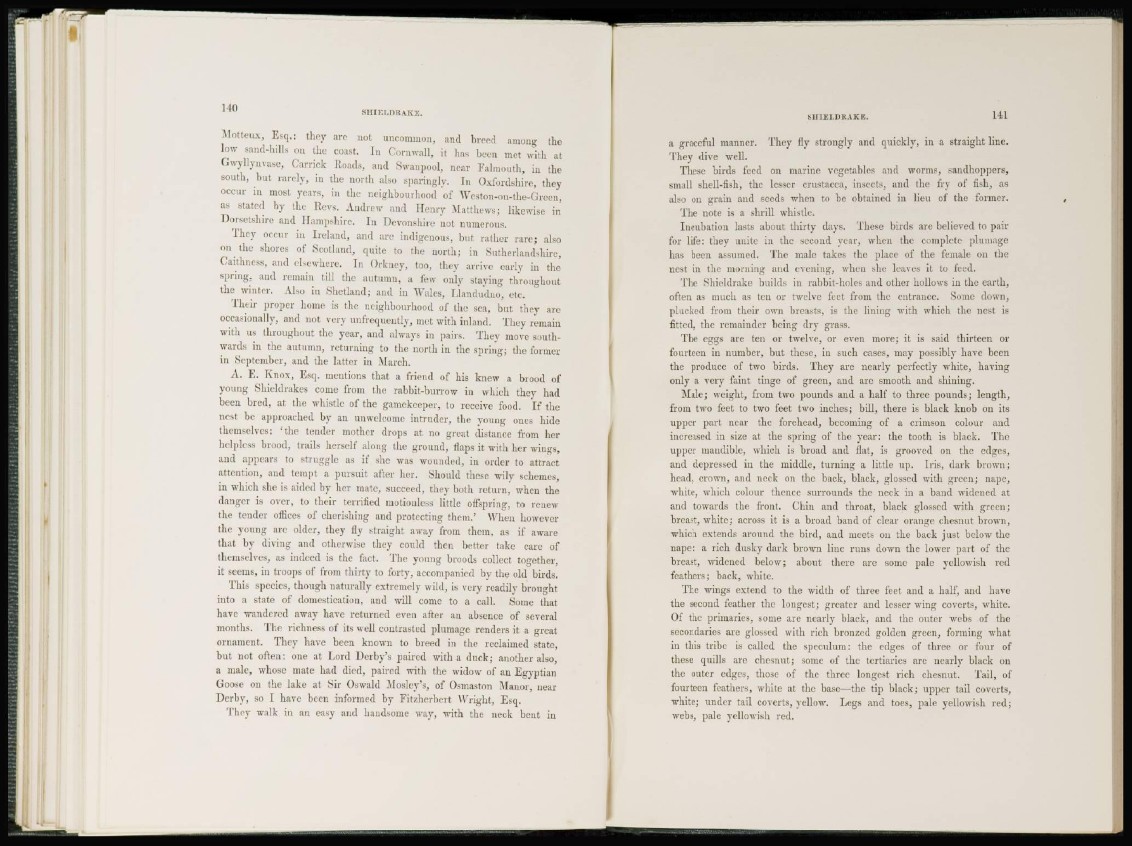
1 10 S H I E L D T t A K E .
Motteux, Esq.: they are not uncommon, and breed among the
low sand-hills on the coast. In Cornwall, it has been met with at
Gwyllynvase, Carrick Roads, and Swanpool, near Falmouth, in the
south, but rarely, in the north also sparingly. In Oxfordshire, they
occur in most years, in the neighbourhood of Weston-on-t he-Green,
as stated by the Revs. Andrew and Henry Matthews; likewise in
Dorsetshire and Hampshire. In Devonshire not numerous.
They occur in Ireland, and are indigenous, but rather rare; also
on the shores of Scotland, quite to the north; in Sutherlandshire,
Caithness, and elsewhere. In Orkney, too, they arrive early in the
spring, and remain till the autumn, a few only staying throughout
the winter. Also in Shetland; and in Wales, Llandudno, etc.
Their proper home is the neighbourhood of the sea, but they are
occasionally, and not very unfrequenlly, met with inland. They remain
with us throughout the year, and always in pairs. They move southwards
in the autumn, returning to the north in the spring; the former
in September, and the latter in March.
A. E. Knox, Esq. mentions that a friend of his knew a brood of
young Shieldrakes come from the rabbit-burrow in which they had
been bred, at the whistle of the gamekeeper, to receive food. If the
nest be approached bv an unwelcome intruder, the young ones hide
themselves: ' t h e tender mother drops at no great distance from her
helpless brood, trails herself along the ground, flaps it with her wings,
and appears to struggle as if she was wounded, in order to attract
attention, and tempt a pursuit after her. Should these wily schemes,
in which she is aided by her mate, succeed, they both return, when the
danger is over, to their terrified motionless little offspring, to renew
the tender offices of cherishing and protecting them.' When however
the young arc older, they fly straight away from them, as if aware
that bv diving and otherwise they could then better take care of
themselves, as indeed is the fact. The young broods collect together,
it seems, in troops of from thirty to forty, accompanied by the old birds.
This species, though naturally extremely wild, is very readily brought
into a state of domestication, and will come to a call. Some that
have wandered away have returned even after an absence of several
months. The richness of its well contrasted plumage renders it a great
ornament. They have been known to breed in the reclaimed state,
but not often: one at Lord Derby's paired with a duck; another also,
a male, whose mate had died, paired with the widow of an Egyptian
Goose on the lake at Sir Oswald Mosley's, of Osmaston Manor, near
Derby, so I have been informed by Fitzherbert Wright, Esq.
They walk in an easy and handsome way, with the neck bent in
S H I E L D R A K E . 141
a graceful manner. They fly strongly and quickly, in a straight line.
They dive well.
These birds feed on marine vegetables and worms, sandhoppers,
small shell-fish, the lesser Crustacea, insects, and the fry of fish, as
also on grain and seeds when to be obtained in lieu of the former.
The note is a shrill whistle.
Incubation lasts about thirty days. These birds arc believed to pair
for life: they unite in the second year, when the complete plumage
has been assumed. The male takes the place of the female on the
nest in the morning and evening, when she leaves it to feed.
The Shieldrake builds in rabbit-holes and other hollows in the earth,
often as much as ten or twelve fect from the entrance. Some down,
plucked from their own breasts, is the lining with which the nest is
fitted, the remainder being dry grass.
The eggs are ten or twelve, or even more; it is said thirteen or
fourteen in number, but these, iu such cases, may possibly have been
the produce of two birds. They are nearly perfectly white, having
only a very faint tinge of green, and are smooth and shining.
Male; weight, from two pounds and a half to three pounds; length,
from two feet to two feet two inches; bill, there is black knob on its
upper part near the forehead, becoming of a crimson colour and
increased in size at the spring of the year: the tooth is black. The
upper mandible, which is broad and flat, is grooved on the edges,
and depressed in the middle, turning a little up. Iris, dark brown;
head, crown, and neck on the back, black, glossed with green; nape,
white, which colour thence surrounds the neck in a band widened at
and towards the front. Chin and throat, black glossed with green;
breast, white; across it is a broad band of clear orange chesnut brown,
which extends around the bird, and meets on the back just below the
nape: a rich dusky dark brown line runs down the lower part of the
breast, widened below; about there arc some pale yellowish red
feathers; back, white.
The wings extend to the width of three feet and a half, and have
the second feather the longest; greater and lesser wing coverts, white.
Of the primaries, some are nearly black, and the outer webs of the
secondaries are glossed with rich bronzed golden green, forming what
in this tribe is called the speculum: the edges of three or four of
these quills are chesnut; some of the tertiaries are nearly black on
the outer edges, those of the three longest rich chesnut. Tail, of
fourteen feathers, white at the base—the tip black; upper tail coverts,
white; under tail coverts, yellow. Legs and toes, pale yellowish red;
webs, pale yellowish red.